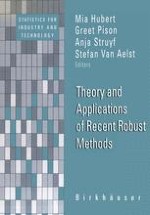2004 | Buch
Theory and Applications of Recent Robust Methods
herausgegeben von: Mia Hubert, Greet Pison, Anja Struyf, Stefan Van Aelst
Verlag: Birkhäuser Basel
Buchreihe : Statistics for Industry and Technology
Enthalten in: Professional Book Archive
